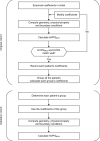Establishment and assessment of the hepatic venous pressure gradient using biofluid mechanics (HVPGBFM): protocol for a prospective, randomised, non-controlled, multicentre study
- PMID: 31796472
- PMCID: PMC6926408
- DOI: 10.1136/bmjopen-2018-028518
Establishment and assessment of the hepatic venous pressure gradient using biofluid mechanics (HVPGBFM): protocol for a prospective, randomised, non-controlled, multicentre study
Abstract
Introduction: Portal hypertension (PH) is a severe disease with a poor outcome. Hepatic venous pressure gradient (HVPG), the current gold standard to detect PH, is available only in few hospitals due to its invasiveness and technical difficulty. This study aimed to establish and assess a novel model to calculate HVPG based on biofluid mechanics.
Methods and analysis: This is a prospective, randomised, non-controlled, multicentre trial. A total of 248 patients will be recruited in this study, and each patient will undergo CT, blood tests, Doppler ultrasound and HVPG measurement. The study consists of two independent and consecutive cohorts: original cohort (124 patients) and validation cohort (124 patients). The researchers will establish and improve the HVPG using biofluid mechanics (HVPGBFM)model in the original cohort and assess the model in the validation cohort.
Ethics and dissemination: The study was approved by the Scientific Research Projects Approval Determination of Independent Ethics Committee of Shanghai Ninth People's Hospital Affiliated to Shanghai Jiao Tong University School of Medicine (approval number 2017-430 T326). Study findings will be disseminated through peer-reviewed publications and conference presentations.
Trial registration number: NCT03470389.
Keywords: biofluid mechanics; hepatic venous pressure gradient; liver cirrhosis; noninvasive; portal hypertension.
© Author(s) (or their employer(s)) 2019. Re-use permitted under CC BY-NC. No commercial re-use. See rights and permissions. Published by BMJ.
Conflict of interest statement
Competing interests: None declared.
Figures






References
Publication types
MeSH terms
Associated data
LinkOut - more resources
Full Text Sources
Medical
